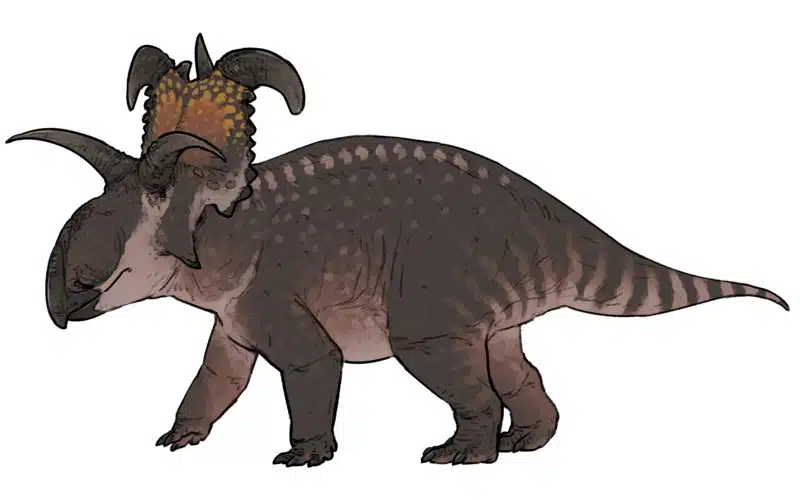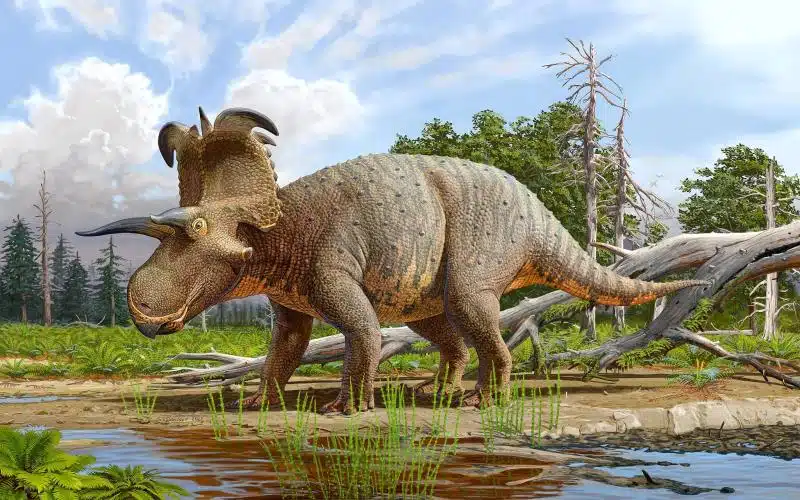Imagine stepping back in time to the Late Cretaceous, about 83.6 to 72.1 million years ago. In this landscape, towering giants and formidable predators roamed. Among these magnificent creatures was Lokiceratops, a Ceratopsian dinosaur with an intriguing name and remarkable features. Discovered in the Loki Quarry of northern Montana, Lokiceratops adds a fascinating chapter to our understanding of prehistoric life.
Lokiceratops, meaning “Loki’s Horned Face,” is a nod both to its distinctive facial structure and its discovery location. As we explore this dinosaur’s origins, physical characteristics, and the world it inhabited, we uncover a story that is as captivating as it is informative.
Lokiceratops Key Facts
| Keyword | Fact |
|---|---|
| Pronunciation | Loh-kee-seh-ruh-tops |
| Meaning of name | Loki Horned Face |
| Group | Ceratopsia |
| Type Species | Lokiceratops rangiformis |
| Diet | Herbivore |
| When it Lived | 83.6 to 72.1 MYA |
| Period | Late Cretaceous |
| Epoch | Campanian |
| Length | 22.0 ft |
| Height | 6.5 ft at hips |
| Weight | 5.5 tons |
| Mobility | Moved on all four |
| First Discovery | 2019 by Mark Eatman |
| Described by | 2024 by Mark Loewen, Joseph Sertich, Scott Sampson, Jingmai O’Connor, Savhannah Carpenter, Brock Sisson, Anna Øhlenschlæger, Andrew Farke, Peter Makovicky, Nick Longrich and David Evans |
| Holotype | EMK 0012 |
| Location of first find | Loki Quarry, Judith River Formation, Montana, USA |
Lokiceratops Origins, Taxonomy and Timeline
The name Lokiceratops is both evocative and descriptive. Drawing from Norse mythology, “Loki” hints at the intriguing nature of the dinosaur and at the same time, in reference to the site where it was discovered, the Loki Quarry, in northern Montana, USA, while “ceratops” comes from the Greek words “keras” meaning horn and “ops” meaning face.

Taxonomically, Lokiceratops belongs to the Centrosaurinae (a group of ceratopsids) within the Ceratopsia. This classification places it among some of the most iconic horned dinosaurs like Albertaceratops. The type species, Lokiceratops rangiformis is the sole member of the genus.
Living during the Campanian Epoch of the Late Cretaceous Period, Lokiceratops lived during the Campanian (83.6 to 72.1 million years ago). U-Pb analyses of zircons dated the sole specimen of Lokiceratops to 78.5 Ma.
Discovery & Fossil Evidence
In 2019, the rich fossil beds of the Loki Quarry in northern Montana revealed an extraordinary find. Mark Eatman unearthed the first known specimen of Lokiceratops, catalogued as EMK 0012. This discovery included a partial skull and skeleton, offering a glimpse into the structure and life of this ceratopsian.
Subsequent searches in the area have yet to yield additional specimens directly linked to Lokiceratops (same individual), underscoring the importance of the initial find. The degree of preservation in the original fossil is exceptional and allows paleontologists to study its anatomical features in detail, providing valuable insights into its biology and ecology.
The fossils found include significant portions of the skull, which showcase the distinctive horns and frill characteristic of ceratopsians. These elements are crucial for understanding not only the physical appearance but also the possible behaviors and ecological roles of Lokiceratops.
- Mounted skull of Lokiceratops
- Frill of Lokiceratops
Lokiceratops Size and Description
Short Description of Lokiceratops
Picture a robust dinosaur standing on four sturdy legs, with a large head adorned with striking horns and a prominent frill. Lokiceratops had a broad, muscular body covered in tough, scaly skin. Its head was the most distinctive feature, with a pair of horns likely used for defence and social interactions. The frill, extending from the back of the head, added to its imposing presence.
Size and Weight of Type Species
Lokiceratops basal skull length is 3 feet, and the specimen was estimated to be at least 20% larger than other ceratopsians like Medusaceratops. Its likely massive weight and length indicate a creature well-adapted to a life of grazing and migration. Its overall build suggests a height that complemented its length and weight, providing a balanced and formidable stature.
The Dinosaur in Detail
The sole specimen of Lokiceratop includes a well-preserved skull and partial skeleton, allowing paleontologists to study its anatomy in detail. The skull, with its distinct horn arrangement and frill, provides insights into the evolutionary pressures that shaped these features. The partial skeleton offers clues about its locomotion and overall body structure, helping to reconstruct its behavior and lifestyle. These findings highlight the importance of Lokiceratops in understanding ceratopsian evolution and diversity.
The detailed study of Lokiceratops’ physical traits reveals its survival strategies. Its robust build and specialized teeth were adapted for processing tough, fibrous plants, indicating a diet that took full advantage of the Late Cretaceous environment. The combination of defensive horns, social display frills, and dietary adaptations illustrates a well-rounded survival strategy. Lokiceratops not only thrived in its ecosystem but also played a vital role in maintaining the balance of its habitat, contributing to the dynamic interplay of species during its time.
Lokiceratops Illustration Sketch
Contemporary Dinosaurs
Present in this period is Corythosaurus, a hadrosaurid known for its distinctive helmet-like crest. Corythosaurus shared the same lush floodplains with Lokiceratops, both dinosaurs being herbivores. The coexistence of these two giants suggests a diverse plant ecosystem capable of supporting multiple large herbivores. Corythosaurus, with its specialized beak, might have fed on different types of vegetation than Lokiceratops, reducing direct competition and allowing for a balanced ecological niche.
One of the contemporaries is Gorgosaurus, a fearsome theropod predator. This agile and powerful hunter posed a significant threat to herbivores like Lokiceratops. The presence of Gorgosaurus in the same region highlights the predator-prey dynamics that shaped the behaviors and adaptations of herbivorous dinosaurs. Lokiceratops, with its defensive horns and frill, was well-equipped to deter such predators, showcasing an evolutionary arms race between the hunters and the hunted.
Another dinosaur that shared the landscape with our main dinosaur is Hadrosaurus, another herbivorous dinosaur but with a different feeding strategy. Hadrosaurus’ robust jaw structure allowed it to process tougher plant materials, which complemented the dietary habits of Lokiceratops. Their coexistence indicates a thriving and varied plant life that supports multiple herbivorous species, each with unique adaptations for survival.
Another contemporary is Appalachiosaurus, a lesser-known theropod that roamed the same territories. Appalachiosaurus likely competed with Gorgosaurus for prey, creating a dynamic predator landscape. This competition would have indirectly influenced the behavior of Lokiceratops, pushing it to develop better defense mechanisms and social strategies to avoid predation. The interactions between these predators and herbivores paint a complex picture of life in the Late Cretaceous, where survival required constant adaptation and vigilance.
Interesting Points about Lokiceratops
- Named after the Norse God Loki and in reference to the Loki Quarry which is the site of its discovery, combining mythology with paleontology.
- The only known specimen was discovered in 2019 at Loki Quarry in Montana.
- Distinctive for its large frill and horn structure.
- Part of the Ceratopsidae, known for their horned faces.
- Lived during the Campanian (around -78 Ma) of the Late Cretaceous Period.
Lokiceratops in its Natural Habitat
Lokiceratops thrived in a lush, river-fed floodplain environment that supported a wide variety of plant life. The climate was warm and temperate, ideal for the growth of ferns, cycads, and maybe flowering plants that made up its diet (bear in mind that flowering plant only appeared sometimes during the Jurassic and they were not as diverse as they are now). As a herbivore, this dinosaur relied on these abundant plant resources, which shaped its daily movements and social behavior.
Living in herds, Lokiceratops likely used its numbers as a defence mechanism against predators, and probably using his horns. Its four-legged locomotion, combined with its significant weight, made it a slow but steady mover, well-suited for grazing over large areas. This social structure and movement pattern suggest a well-adapted creature within its ecosystem.
The physical adaptations of Lokiceratops, from its horns to its frill, also played roles in social interactions and possibly even thermoregulation. These features reflect a complex interplay of survival strategies that enabled this dinosaur to thrive in its natural habitat.
Frequently Asked Questions
The name “Loki’s Horned Face,” was given in based on the Norse God Loki and in
reference to the Loki Quarry which is the site of its discovery.
It measured about 22.0 feet in length and weighed approximately 5.5 tons.
As a herbivore, it fed on a variety of tough, fibrous plants found in its environment.
The only known specimen was discovered at Loki Quarry in northern Montana.
This dinosaur lived during the Campanian Epoch of the Late Cretaceous Period, around 83.6 to 72.1 million years ago.
Its distinctive horns and large frill, as well as its connection to Norse mythology, set it apart from other ceratopsians.
Sources
The information in this article is based on various sources, drawing on scientific research, fossil evidence, and expert analysis. The aim is to provide a comprehensive and accurate overview of Lokiceratops. However, please be aware that our understanding of dinosaurs and their world is constantly evolving as new discoveries are made. As of today (June 2024), Lokiceratops is a new dinosaur whom the description has just been released.
Article last fact checked: Joey Arboleda, 06-25-2024
Featured Image Credit: Ddinodan, CC BY 4.0, via Wikimedia Commons



